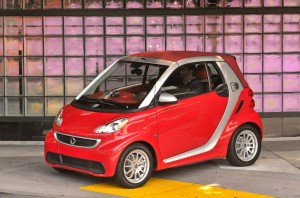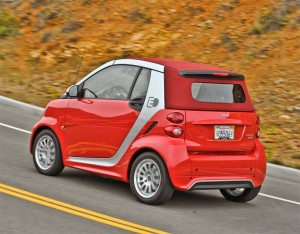Taking a cue from competitors who have boosted sales by cutting costs, Smart has trimmed the monthly lease price of its Fortwo Electric Drive, or ED, model by nearly a third – while also introducing a new “Battery Assurance Plan” meant to assure the vehicle delivers the promised performance and range as long as it is in an owner’s hands.
The microcar division of Daimler AG – and sister to the Mercedes-Benz brand – Smart introduced its third-generation Electric Drive model earlier this year, company officials insisting they are committed to battery power for the long haul despite the slow growth in demand for the clean, lower-cost alternative.
“We feel it’s a no-brainer. It just makes sense,” said Smart’s new General Manager Mark Webster, during an introduction of the latest Fortwo ED model and the new battery warranty program.
Motorists can still buy the battery version of the Smart Fortwo but the maker is encouraging them to lease the vehicle instead. When the gen-3 ED was launched the maker had priced it at $199 a month – which actually included $119 for the car itself and another $80 a month for the Battery Assurance Plan. The new price drops to just $139 a month, Webster announced.
The special warranty, among other things, guarantees that the battery will maintain at 80% of its original charge capacity or it will be swapped out for a fresh battery.
Curiously, due to the vagaries of how resale values are determined, someone who might choose to skip the Battery Assurance Plan would have to pay about $400 a month to lease the Smart Fortwo ED, noted Webster – which he says it likely why 80% of the initial customers have opted for the program.
(GM slashes price on Chevrolet Volt. Click Herefor details.)
Those who prefer to purchase, rather than lease a Smart Fortwo ED can also get a discount opting for the new program. For them, with the new price cuts – and with various state and local incentives for battery cars – the ultimate price can come in at or around $10,000 plus that $80 for the monthly battery warranty plan.
Smart has made a number of upgrades with the 2013 Fortwo ED. The new model features a 17.6 kilowatt-hour lithium-ion battery that can deliver an EPA-estimated 76 miles range in city driving. The federal agency rates the gen-3 model at 107 MPGe, or miles per gallon-equivalent.
The previous, second-generation ED delivered a mere 27 horsepower under normal conditions, with an electric turbo mode that bumped that to 40 hp. It took a full 26.7 seconds to launch from 0 to 60. The new 2013 Smart Fortwo ED now makes 47 hp and a peak 74. And it will hit 60 in just 11.5 seconds – which is actually 1.2 seconds faster than the gasoline-powered Smart Fortwo.
Charging time on 240 Volt current is down 25%, to six hours. The U.S. version of the new ED does not have high-speed quick charge capability, “but it’s something we’re watching,” said program manager Mike Martin.
Don’t be surprised to see that and other improvements follow when the fourth generation Electric Driver comes to market later in the decade, company officials hinted.
(BMW reveals new i3 battery-car, prices it at $42,000. Click Herefor more.)
After an unusually long run, Smart is finally preparing to replace the aging Fortwo with an all-new model for the 2016 model-year, confirmed Webster. For now, he added, there are no plans to bring a second product line, the four-door Smart Forfour, to the U.S.
But potential buyers will see a wide range of both body “variants” as well as powertrains for the next version of the Smart Fortwo, Webster told TheDetroitBureau.com during an interview in Ann Arbor following a drive of the latest electric car.
That could include a four-seat version, perhaps even a variant picking up on the wagon-like concept Smart showed a few years ago.
On the powertrain side, the 2016 Smart Fortwo will debut with an upgraded gasoline engine and an all-new transmission – which it hopes will resolve the most frequent complaint about the 2-seater, its rough-shifting gearbox. Over the next few years after introduction, Smart will follow with a gen-four version of the Electric Drive and will offer other alternative power systems that might range from a diesel to a fuel-cell system, Webster suggested.
“You will see a lot of different variants,” stressed Webster, as he described the brand’s product plans, adding that, “It’s about being modern and fun and innovative.”
While Smart is “never going to be a mass market brand,” the new general manager said he expects that shifting market trends will give the long-struggling brand a boost over the next few years. After an initial burst of interest following its 2007 debut, Smart sales have plummeted. But the maker is betting it can gain some more traction as it expands its range of offerings.
While Webster wouldn’t discuss hard numbers, he hinted that Smart expects the third-generation Fortwo ED will itself generate sales in the “four-figures” range.
Smart is just the latest in a growing list of battery-car makers trimming prices to boost demand. Earlier this week, Chevrolet cut $5,000 off the price for the 2014 version of its Volt plug-in hybrid. Nissan spurred a major jump in demand when it slashed the price on its Leaf battery-electric vehicle earlier in the year.
(EV makers slash prices to spur sales. Click Here for the full story.)


